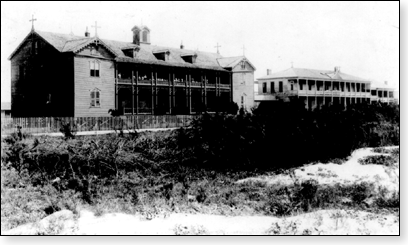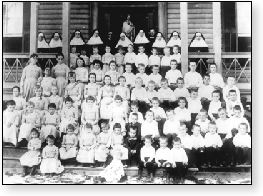The Orphanage tragedyremembered

The Sisters of Charity Orphanage
Wherever they are in the world on Sept. 8, the members of the Congregation of the Sisters of Charity of the Incarnate Word sing an old French hymn, "Queen of the Waves."
Whether in their ministry in rural Kenya, East Africa or one of the hospitals of the Sisters of Charity Health Care System, which they sponsor, the Sisters of Charity sing the same hymn that has been sung on that date every year since 1900.
The song provides the sisters and all those who co-minister with them an opportunity to pause and remember all who lost their lives in a devastating hurricane almost a century ago.
Striking Galveston on Sept. 8, 1900, the Great Storm is considered the worst natural disaster in the nation's history.
More than 6,000 men, women and children lost their lives. Among the dead were 10 sisters and 90 children from the St. Mary's Orphans Asylum, operated by the Sisters of Charity.
The sisters also operated St. Mary's Infirmary in Galveston. It was the first Catholic hospital in the state, established in 1867.
The sisters were called to Galveston by Catholic Bishop Claude M. Dubuis in 1866 to care for the many sick and infirm in what was the major port of entry for Texas. They were also charged with caring for orphaned children, most of whom had lost parents during yellow fever epidemics.
At first the Sisters of Charity opened an orphanage within the hospital, but later moved it three miles to the west on beach-front property on the former estate of Captain Farnifalia Green.
The location seemed ideal as it was far from town and the threat of yellow fever.
As Galveston entered the new millennium, it was one of the wealthiest cities per capita in the United States and one of the largest in the state.
It was a prosperous community with a bustling port. With a population of 36,000, Galveston appeared to be poised for greatness.
And then one weekend in September in 1900, the same proximity to the sea that had made the community grow and prosper as a port city, was to change Galveston Island forever. On Sept. 8, Galveston became the victim of a powerful hurricane of such destructive force that whole blocks of homes were completely swept away and one sixth of population was killed.
Beginning early on the morning of Saturday, Sept. 8, 1900, the winds began coming in strongly from the north. Despite the opposing winds, the tides of the southern gulf waters also rose sending large crashing waves upon the beach front.
Sister Elizabeth Ryan, one of 10 sisters at St. Mary's Orphanage, had come into town that morning to collect food. Despite pleas from Mother Gabriel, the assistant superior at St. Mary's Infirmary, for her to stay at the hospital until the storm passed, Sister Elizabeth said she had to return to the orphanage.
Sister Elizabeth said that she had the provisions in the wagon and if she did not return the children would have no supper. She didn't know that whether she returned or not there would be no more suppers at the orphanage.
During the afternoon the winds and rain continued to increase. The tides of the gulf rose higher and higher with fierce waves crashing on the beach sending flood waters into the residential areas.
St. Mary's Orphanage consisted of two large two-story dormitories just off the beach behind a row of tall sand dunes that were supported by salt cedar trees. The buildings had balconies facing the gulf.
According to one of the boys at the orphanage, the rising tides began eroding the sand dunes "as though they were made of flour." Soon the waters of the gulf reached the dormitories.
The Sisters at the orphanage brought all of the children into the girls' dormitory because it was the newer and stronger of the two. In the first floor chapel, they tried to calm the children by having them sing "Queen of the Waves." The waters continued to rise.
Taking the children to the second story of the dormitory, the Sisters had Henry Esquior, a worker, collect clothesline rope. Again they had the boys and girls sing "Queen of the Waves."
One of the boys later said that the children were very frightened and the Sisters were very brave.
By 6 p.m. the wind was gusting past 100 miles per hour and the waters of the gulf and bay had met, completely flooding the city. Residents climbed to the second stories, attics and even roofs of their homes. Flying debris struck many who dared venture outside their homes.
Around 7:30 p.m. the main tidal surge struck the south shore.
Houses along the beach front were lifted from their foundations and sent like battering rams into other houses. Houses fell upon houses.
At St. Mary's Infirmary the flood waters filled the first floor. From the second story balcony, the sisters pulled refugees in as they floated by and brought them into the over-crowded hospital. Almost every window in the facility was broken out sending the wind and rain whipping through the building.
At the orphanage, the children and sisters heard the crash of the boys dormitory as it collapsed and was carried away by the flood waters.
The sisters cut the clothesline rope into sections and used it to tie the children to the cinctures which they wore around their waists. Each Sister tied to herself between six to eight children.
It was a valiant, yet sacrificial effort to save the children. Some of the older children climbed onto the roof of the orphanage.
Eventually the dormitory building that had been the sanctuary for the children and sisters was lifted from its foundation. The bottom fell out and the roof came crashing down trapping those inside.
Only three boys from the orphanage survived: William Murney, Frank Madera and Albert Campbell. Miraculously all three ended up together in a tree in the water. After floating for more than a day, they were eventually able to make their way into town where they told the sisters what had happened at the orphanage.
One of the boys remembered a sister tightly holding two small children in her arms, promising not to let go.
The sisters were buried wherever they were found, with the children still attached to them. Two of the sisters were found together across the bay on the Mainland. One of them was tightly holding two small children in her arms. Even in death she had kept her promise not to let go.
The death and destruction in Galveston was unbelievable. More than 6,000 were dead and their bodies were littered throughout the city. It would be months before some would be uncovered. A complete list of the dead was never made.
It is estimated that the winds reached 150 mph or maybe even 200. The tidal surge has been estimated at from 15 to 20 feet.
Whole blocks of homes had been completely destroyed leaving little more than a brick or two. In all more than 3,600 homes had been destroyed.
A great wall of debris wrapped itself around St. Mary's Infirmary on the eastern end of the city and then zigzagged through the city to the beach. At places the wall was two stories tall.
Inside this great wall were destroyed houses, pieces of furniture, pots, pans, cats, dogs and people. Those who were dead and those who were dying.
At St. Mary's Infirmary, there was no food or water. While the main hospital building was still standing, the adjacent structures, had been destroyed.
The hospital was packed with those who were injured and those who had no where else to go. Two of the Sisters walked about the area until they found crackers and cookies that had been soaked in the water. They brought them back to the hospital and over a fire they built in the street they dried the food and served it to those in need at the infirmary.
Firmly committed to the healing ministry of Jesus Christ, the Sisters repaired St. Mary's Infirmary and, one year later, opened a new orphanage. Today the sisters have extended their ministry to other states and foreign countries.
On Sept. 8, 1994, a Texas Historical Marker was placed at 69th Street and Seawall Boulevard, marking the site of the former orphanage.
The descendants of two of the survivors, Will Murny and Frank Madera, returned to participate in the marker dedication.
As part of the ceremony, "Queen of the Waves" was again sung at the same time and place as it was during the Great 1900 Storm. And, as it continues to be each Sept. 8 by the Sisters of Charity of the Incarnate Word.
Linda Macdonald is Director of Communications, Congregation of the Sisters of Charity of the Incarnate Word in Houston.
